I recently caught up with Karen Bockel, one of our go-to guides and someone I am proud to call a great friend. Guides come in all forms, each with a unique story. Karen is a reformed rocket scientist (literally!), who has followed her passion for being in wild places, a passion that has led her into the mountain guiding profession. I asked Karen a few questions in the hope that we might help you understand a bit more about what it is like to be a guide.
-Todd Rutledge, Ophir, CO
T: Why did you choose to become a Mountain Guide?
K: I love being out in the mountains and sharing that experience with others. To be a mountain guide was also a childhood dream of mine, but I never thought I could actually do it… until I started to work as a guide and realized I was good at it! To teach climbing skills, summit a big peak, make powder turns in fresh snow, and inspire a climber to reach new heights, that’s what I love about guiding.
T: What experience did you have when you started guiding?
K: I went on an expedition with three girlfriends (Sonja Nelson, MT guide, Kim Grant, MT guide, and Kim Havell) to ski from the summit of Denali. I learned a lot about expeditions from the girls on that trip. Along the way I got to see quite a few Mountain Trip teams on the mountain, got to know them and their jobs, and see how they were working. I liked the commitment, hard work, and friendships formed on expeditions. The Mountain Trip teams were like a big family, all working together toward a common goal. It was awesome to see that, and I wanted to be part of it.
Before I started guiding, I had already spent a good deal of time in the mountains. I had been exploring the local ranges in Colorado, climbing long multi-pitch rock routes and skiing lots of peaks and awesome descents. I also honed my mountain sense in remote places like the Andes in South America, and the Rockies in Canada.
T: What sort of courses, education or certifications have you taken along the way (in and out of guiding)?
K: Wow! I have been pretty busy taking courses and working towards earning my American Mountain Guides Association (AMGA) Certifications. So far, I have taken the following:
AMGA courses would include my Rock Instructor Course (with you, Todd!), Ice Guide Course, Alpine Guide Course, Rock Guide Course/Aspirant Exam, Ski Guide Course, Ski Mountaineering Guide Course/Aspirant Exam, Rock Guide Exam.
Additionally, I am American Avalanche Institute Level III certified and hold current certifications for Wilderness First Responder and Outdoor Emergency Care, and CPR for healthcare providers. I am also an American Avalanche Association Professional member and have taken a Rigging for Rescue Seminar.
On the academic front, I hold a M.S. in Atomic and Laser Physics. Oh yeah, I speak English, French, and Spanish, which is really fun.
T: Where have you guided?
K: I have guided in some great places: Denali and the Alaska Range, my favorite stomping grounds; of course my home range, the San Juans in Colorado; the beautiful Tetons in Wyoming, as well as the Wind River Range; and Red Rocks, a world-class rock climbing destination outside of Las Vegas, Nevada.
T: What is the most rewarding part of the job?
K: I think I answered that in the first question? When my climbers are stoked at the end of the day, then so am I!
T: What is one of the greatest challenges of the job?
K: Being a guide is a serious job! I always think about the potential hazards of the day, be it the potential for a crevasse fall, or a slip on the ice, loose rock, or something else. I try the best I can to minimize those risks, and guide a safe and rewarding climb. On top of that, there are constantly decisions to be made, about the route, the way we climb, when to start, to stop, or to turn around, evaluating the conditions, the weather, and so on. Sometimes, it can be stressful to make decisions when the stakes are high, for example when you’re in a remote place and don’t have all the information you would like.
T: What are your goals in the profession?
K: To be the best I can be! I seek out opportunities to learn from other guides, and gain insight from their experiences. I am continuously learning and growing as a guide, and I love the challenges of guiding out in the mountains, they keep me young!
T: Oh yeah? How old are you? NO WAIT- I’ll retract that question!!! OK, how do you train and/or keep your skills fresh?
K: I used to be a professional athlete, so training is in my blood… I often go out for a trail run after a day of work, or a mountain bike ride. Rock climbing is my passion, and when there is a break in the guiding season, you can usually find me on some rock somewhere. This fall I went to Yosemite for a few days and climbed Half Dome and El Capitan. As far as technical skills go, I love working with ropes and carabiners and pulleys! I try to keep up on rigging techniques and new ideas for guiding technical terrain. I am involved with the local Search and Rescue team and run some of their trainings. Also, I am working on getting internationally certified as a mountain guide, which provides me with lots of education and training.
T: You have been coming up to work with us on Denali for years now. How do you return to the same venue over and over, yet still keep it fresh for your guests?
K: Every expedition is different, and the mountain shows a different face each time I visit it. The beauty of the Alaska Range alone draws me back every season. New friendships are formed, new trails are traveled…
T: How do you manage risk on big, cold mountains? If that is too vague, maybe give me one instance of how you managed risk on a recent trip.
K: Being on a remote mountain for a 3 week expedition is a serious undertaking. I try to plan ahead and anticipate what might happen on a given day. By thinking about the risks that we might encounter, I am better prepared to deal with them should they occur. On my second trip last year, we had to descend a long section in a complete whiteout. Even though we could hardly tell whether the next step was up or down, I was able to descend safely from 11,200′ to Ski Hill (7,800′) using my navigation skills: I had my GPS in one hand looking at the waypoints I had created on the ascent, and my skipole in the other, probing as I was forging ahead… By planning ahead, my systems worked and we made it to basecamp the next day.
T: Do you have any tips or advice for people who are considering climbing a big, cold mountain? Give us one specific thing that you do to take care of yourself in an unforgiving environment.
K: My number one tip is to have an open mind and a good attitude. It is hard to imagine what it’s like to be up high, and being able to deal with the unexpected is a huge part of expedition climbing. If you can keep a cheerful attitude, and sometimes lend a hand to a team member when they need it or accept a favor from one of them when you need it, you will have a good experience. Expedition climbing is all about teamwork, and an expedition team who works together well has a much higher chance of success.
I really try to take care of myself on an expedition. Eating and staying hydrated as well as getting enough sleep is important. Something I bring something for myself that’s not on the equipment list: a puffy skirt! It’s kind of a girly thing, but fun to wear, super comfy and keeps me warm around camp.
T: What do you do for fun in your spare time?
K: Spare time, what is that?! Just kidding… When you work hard, you also have to know how to relax. In the winter, I like hanging out in the little cabin I rent in Telluride with a second cup of coffee and knitting a hat.
T: Who is you favorite boss? 😉
D) All the above! Bill and Todd. I am so lucky to have you guys as my friends and my bosses.
T: Thanks a ton, Karen! Enjoy your autumn and let us know when you hear the results from your Rock Guide Exam you recently took.

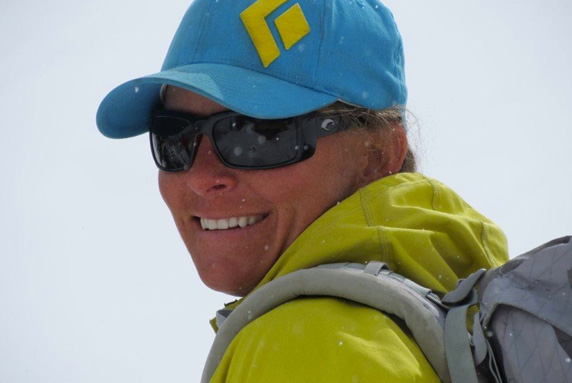
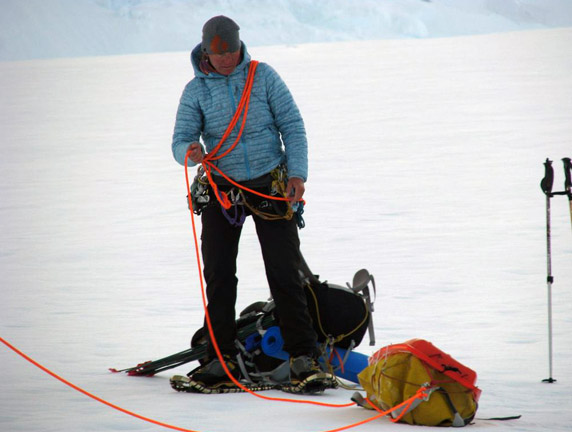
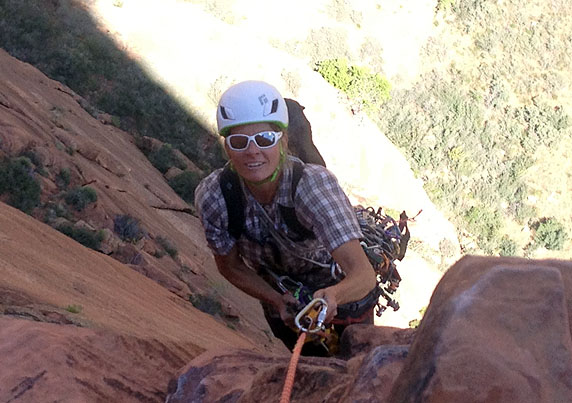
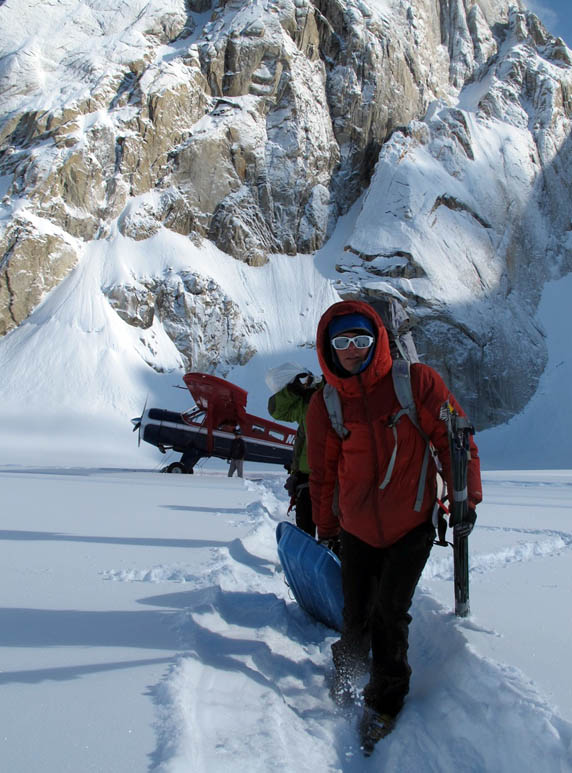
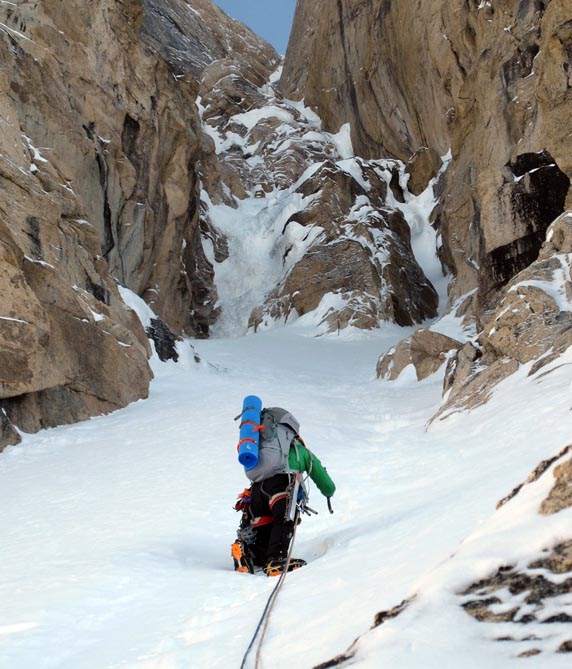
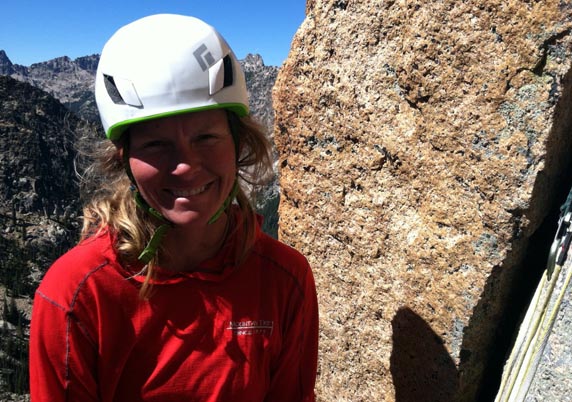
Karen amazing what you are doing you don’t know but I followed your beginning career in running at nordhoff in ojai both my girls were/are runners my oldest birdie hatch came after you was on two state championship teams has four school records and ran at ucla she currently lives in Brooklyn and although married with two kids competes in Olympic triathlon and will compete in the national championships in Milwaukee I read about your brother dirk amazing my youngest daughter Bessie went to thatcher and was div 5 cross country champion then ran at Tulane but after firest was injured and when to chile for two years with Nols climbing men’s and kayaking in the ocean. Great to seeing you pursuing your passion best of luck bill hatch